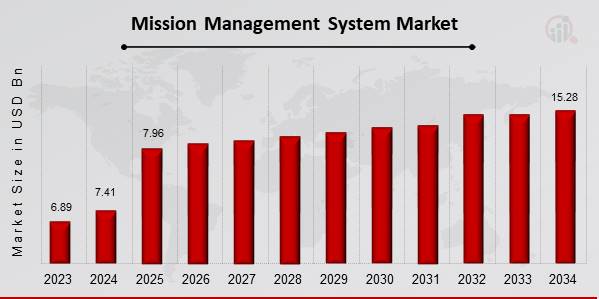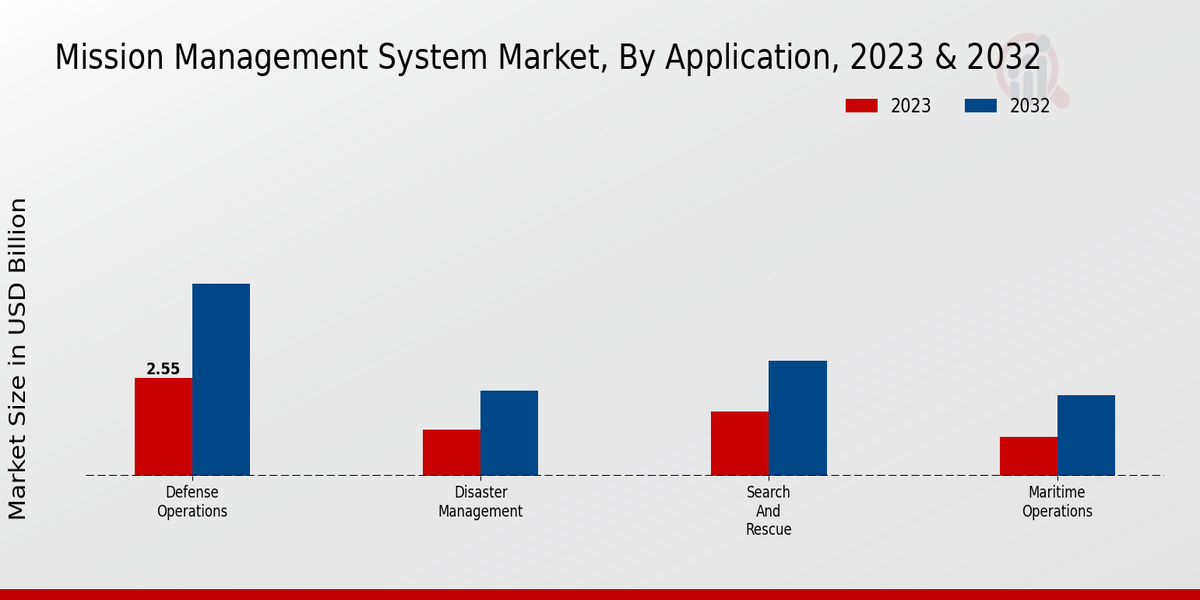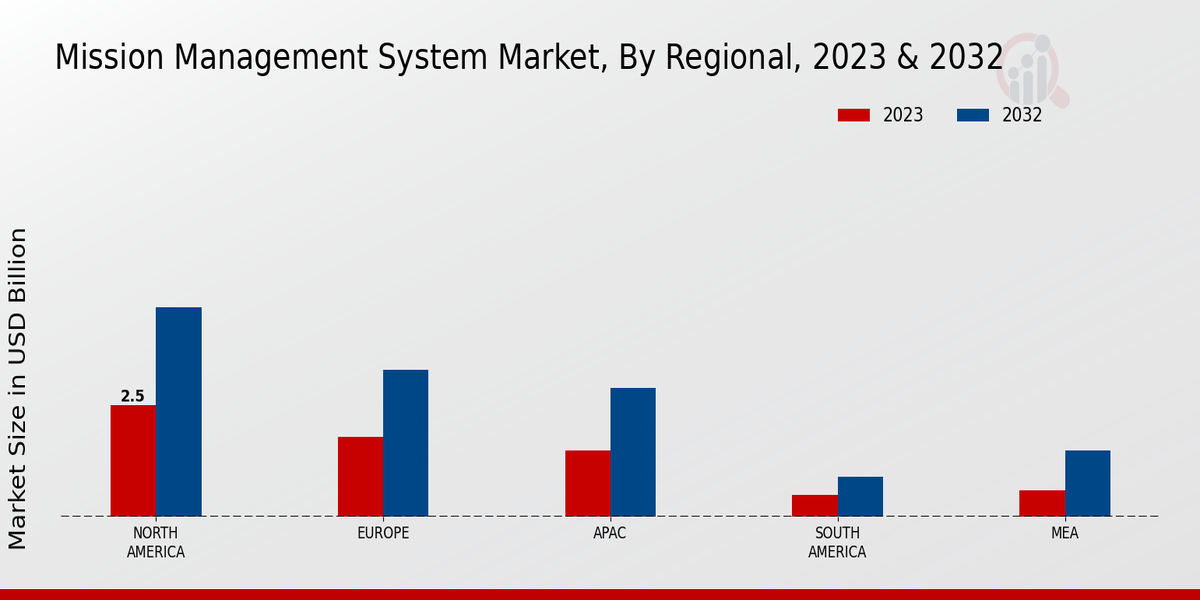Global Mission Management System Market Overview:
Mission Management System Market Size was estimated at 7.41 (USD Billion) in 2024. The Mission Management System Market is expected to grow from 7.96 (USD Billion) in 2025 to 15.28 (USD Billion) by 2034. The Mission Management System Market CAGR (growth rate) is expected to be around 7.51% during the forecast period (2025 - 2034).

Source: Primary Research, Secondary Research, MRFR Database and Analyst Review
Key Mission Management System Market Trends Highlighted
The Mission Management System Market is currently influenced by several key market drivers, including the increasing need for efficient operations across various sectors and the growing demand for improved decision-making processes.
Organizations are striving to enhance coordination and communication, and this has driven the adoption of mission management systems.
The desire to streamline tasks, reduce operational costs, and improve overall productivity has led many enterprises to implement these systems, fostering a shift towards advanced technological solutions that cater to specific mission needs.
There are numerous opportunities to be explored in this evolving market, particularly through the integration of artificial intelligence and data analytics.
Companies can leverage these technologies to gain deeper insights into operational data, thereby improving mission preparedness and response capabilities. The demand for customization and scalable solutions presents an avenue for firms to differentiate their offerings, tapping into niche markets that require targeted mission management solutions.
Additionally, collaboration with technology partners can enhance capabilities, allowing organizations to innovate and stay ahead of the competition. In recent times, trends such as cloud-based solutions and mobile accessibility have gained momentum, making mission management systems more versatile and user-friendly.
The shift towards remote and hybrid work environments has increased the importance of flexible systems that can be accessed from various locations.
Moreover, there is a growing emphasis on cybersecurity measures due to the rise in digital threats, prompting companies to develop more robust security protocols within their mission management systems.
This trend highlights the necessity of ensuring data integrity and protection, ultimately fostering trust among users while navigating the complexities of modern operational environments.
Mission Management System Market Drivers
Growing Importance of Enhanced Operational Efficiency
In the evolving landscape of the Mission Management System Market, organizations are increasingly prioritizing operational efficiency. The demand for systems that can streamline processes, enhance communication, and improve decision-making capabilities is on the rise.
By integrating advanced technologies such as artificial intelligence and data analytics, mission management systems can provide real-time insights and situational awareness, making them indispensable for military and other critical operations.
Companies are investing in solutions that reduce manual interventions and automate various functions, allowing personnel to focus on strategic tasks instead of routine operations.
As the complexities of missions increase, improved efficiency becomes vital to meeting operational goals and responding effectively to challenges.
With the projected growth of the Mission Management System Market, organizations are examining their current methodologies and looking toward innovative solutions that promise greater productivity and reduced costs.
These factors drive the market forward as stakeholders recognize the necessity of evolving from traditional practices to more adaptive, technology-driven frameworks.
Rising Demand for Integrated Solutions
The Mission Management System Market is seeing a notable shift towards integrated solutions that provide a holistic view of mission operations. As organizations strive for comprehensive situational awareness, the ability to consolidate data from multiple sources into a single platform is becoming increasingly critical.
Stakeholders recognize that integrated systems enable better coordination, enhance strategic planning, and improve response times during missions.
As the complexities of global operations expand, tools that can consolidate data and intelligence are in high demand. This transition is set to propel market growth as it addresses both current operational needs and future challenges.
Technological Advancements and Innovations
The rapid evolution of technology plays a crucial role in shaping the Mission Management System Market. As innovations in artificial intelligence, machine learning, and cloud computing continue to emerge, they significantly enhance the capabilities of mission management systems.
The integration of these technologies enables enhanced data processing, predictive analytics, and automated decision-making processes. Organizations are leveraging these advancements to improve their operational readiness and mission success rates.
The ongoing technological progress not only drives current market growth but also lays the foundation for future expansion and the introduction of new, more effective systems.
Mission Management System Market Segment Insights:
Mission Management System Market Application Insights
The Mission Management System Market, particularly in the Application segment, is experiencing robust growth, which reflects the increasing need for effective management across various operations.
The major portion of this market was led by Defense Operations, which holds a significant share with a valuation of 2.55 USD Billion in 2023 and projected to reach 5.0 USD Billion by 2032.
This dominance can be attributed to the growing need for enhanced military capabilities, efficient resource allocation, and the advancement of technologies in defense systems, thus making it a crucial focus area within the Mission Management System Market revenue.
Disaster Management followed closely behind, valued at 1.2 USD Billion in 2023 and expected to grow to 2.2 USD Billion by 2032. The increasing frequency of natural disasters and the urgent need for coordinated response strategies contribute to its significance. This application enhances government and NGO efforts in managing crises effectively, highlighting its role as a critical component for saving lives and protecting communities during emergencies.
Search and Rescue, valued at 1.66 USD Billion in 2023 with a projection of 3.0 USD Billion in 2032, also played a vital role, particularly in response to emergencies and humanitarian aid scenarios. This application is essential for optimizing response times and enhancing operational efficiency during critical interventions, thereby ensuring timely assistance in life-threatening situations.
Maritime Operations, while valued at 1.0 USD Billion in 2023 and anticipated to grow to 2.1 USD Billion by 2032, showcased the importance of mission management in overseeing coastal and offshore activities.
The application of mission management systems in maritime environments is critical for ensuring safety, compliance with regulations, and effective resource management, especially with the increasing global trade and maritime activities.
Overall, the Mission Management System Market segmentation reveals a landscape marked by strategic investments across diverse applications. The sector demonstrates significant opportunities for improvement through technological advancements, operational efficiency, and innovative solutions.
The market growth is further supported by global trends toward enhanced inter-agency collaboration, improved decision-making frameworks, and the increasing adoption of automation and digital systems across all applications.
Challenges such as budget constraints and the need for comprehensive training and development in these sectors must also be addressed to unlock full market potential. Each segment collectively contributes to the strategic operations essential in today's complex environments, signifying their individual and collective importance in driving the Mission Management System Market statistics upwards.

Source: Primary Research, Secondary Research, MRFR Database and Analyst Review
Mission Management System Market Deployment Type Insights
The Mission Management System Market is poised for growth, driven by its Deployment Type segment, which is critical in shaping market dynamics.
The Deployment Type segment is categorized into On-Premises, Cloud-Based, and Hybrid solutions, each serving distinct operational needs. On-premises solutions often appeal to organizations prioritizing data security and control, while Cloud-Based offerings are favored for their flexibility and reduced IT overhead.
Hybrid models have emerged as a significant choice for entities seeking to balance the benefits of both On-Premises and Cloud-Based systems. The evolution of these deployment types shows the industry's response to growing digital transformation demands and real-time operational efficiency.
As organizations increasingly look to optimize their mission management capabilities, the integration of these deployment types is expected to play a vital role in enhancing operational effectiveness. Overall, the deployment type landscape within the Mission Management System Market is a vital area, reflecting broader trends in technology adoption and operational strategies.
Mission Management System Market End Use Insights
The Mission Management System Market is poised for substantial growth, particularly driven by its diverse End Use applications.
The demand within the Government sector is largely fueled by the need for enhanced operational efficiency and strategic planning. In the Military realm, the focus on precision and real-time decision-making ensures that this segment plays a crucial role in market expansion.
The Commercial sector benefits from automation and optimized resource allocation, enabling businesses to improve their operational capabilities. Meanwhile, Non-Profit organizations leverage mission management systems to enhance coordination and mission effectiveness, leading to greater societal impact.
Collectively, these segments contribute significantly to the overall growth trajectory of the Mission Management System Market, reflecting robust Mission Management System Market revenue potential.
The evolving dynamics of these sectors underline the importance of the Mission Management System Market data, highlighting opportunities while also presenting challenges regarding integration and technological advancements.
As the market grows, ongoing innovations are expected to shape strategies within these key segments, ensuring they remain relevant in an ever-changing landscape.
Mission Management System Market Component Insights
The market encompasses three primary areas: Software, Hardware, and Services. Software is critical as it facilitates data management and operational planning, making it a driving force for efficiency in mission management systems. Hardware contributes significantly to the functionality of these systems by providing the necessary tools and infrastructure; thus, it holds a major share in the market.
Services, encompassing support and maintenance, are equally important as they ensure the continual evolution and reliability of mission management systems, catering to diverse customer needs. The Mission Management System Market statistics reveal an upward trend, supported by the increasing adoption of advanced technologies and growing demand for automated solutions.
Market growth is driven by the need for enhanced operational efficiency and decision-making capabilities across various sectors. However, challenges such as integration complexities and high installation costs may arise.
Overall, the Mission Management System Market segmentation highlights the critical nature of these components, showcasing their importance in the sector's current landscape and future developments.
Mission Management System Market Regional Insights
The Mission Management System Market revenue reflects a substantial presence across various regions, with North America leading the market, valued at 2.5 USD Billion in 2023, and projected to grow to 4.7 USD Billion by 2032, capturing a significant portion of the industry’s demand.
Europe followed closely, starting at 1.8 USD Billion and reaching 3.3 USD Billion, indicating strong growth driven by advanced technology adoption. In the Asia-Pacific (APAC) region, the valuation stood at 1.5 USD Billion for 2023, with projections of 2.9 USD Billion, highlighting a rising trend in defense and mission management.
South America contributed a smaller share with values of 0.5 USD Billion initially, expanding to 0.9 USD Billion, while the Middle East and Africa (MEA) displayed an increase from 0.6 USD Billion to 1.5 USD Billion, reflecting growing investments in defense capabilities.
The disparities among these regions showcase the diverse dynamics of the Mission Management System Market segmentation, where North America remains the dominant player, largely due to its investments in advanced military technologies and cybersecurity, while APAC is emerging rapidly, signifying new opportunities in mission management systems as nations enhance their defense strategies.
The overall market growth is driven by technological advancements, increasing defense budgets, and the rising demand for integrated mission solutions, although region-specific challenges may influence market dynamics.

Source: Primary Research, Secondary Research, MRFR Database and Analyst Review
Mission Management System Market Key Players and Competitive Insights:
The Mission Management System Market is characterized by rapid advancements in technology and increasing demand for efficient management of various missions across sectors. Competitive insights reveal a landscape where innovation, adaptability, and customer-centric approaches are paramount.
Key players are vying for market share through the implementation of cutting-edge technologies, like artificial intelligence and data analytics, to enhance decision-making processes. The ongoing evolution in mission-critical operations demands robust systems that facilitate seamless communication and coordination, which has intensified competition among established and emerging players.
The market's growth potential is bolstered by the rising need for integrated solutions that address the complexities of mission management in a fast-paced environment.
Hewlett Packard Enterprise has established itself as a formidable presence in the Mission Management System Market, capitalizing on its extensive experience and technological prowess. The company's strength lies in its ability to provide scalable and flexible solutions tailored to meet the diverse needs of mission-critical operations.
Hewlett Packard Enterprise focuses on enhancing the efficiency and effectiveness of mission management through innovative hardware and software solutions, which integrate seamlessly with existing infrastructures.
The company’s commitment to customer satisfaction is evident in its proactive support services and continuous development of cutting-edge technologies, positioning it as a reliable partner for organizations looking to optimize their mission management capabilities.
Oracle's contributions to the Mission Management System Market are marked by its comprehensive suite of software solutions designed to streamline complex processes. The company's strengths are highlighted by its robust database management systems and cloud offerings that enable organizations to manage data and resources effectively.
Oracle’s strategic focus on innovation allows it to introduce advanced analytics and artificial intelligence capabilities that enhance decision-making and resource allocation in mission-critical environments.
With a strong emphasis on creating user-friendly interfaces and comprehensive support, Oracle continues to strengthen its market position, providing organizations with the tools necessary to navigate the challenges of mission management in a sophisticated landscape.
Key Companies in the Mission Management System Market Include:
Mission Management System Market Developments
The Mission Management System Market has witnessed significant developments recently, reflecting the ongoing evolution of technology and strategic partnerships among major players. Companies like Hewlett Packard Enterprise, Oracle, and General Dynamics are expanding their capabilities to meet the increasing demand for integrated mission management solutions.
Current affairs indicate ongoing collaborations, particularly within the defense and aerospace sectors, where organizations are focusing on enhancing operational efficiencies and decision-making processes. Notably, Cisco Systems and Lockheed Martin have been enhancing their cybersecurity features within mission management systems in response to rising security concerns.
Moreover, there are fresh reports of mergers and acquisitions, especially involving L3Harris Technologies and Honeywell, both of which aim to broaden their market reach and technological prowess. Notably, the market's valuation is experiencing robust growth, driven by increased government and defense spending, as well as the digital transformation initiatives within industries.
The impact is evident as companies such as Microsoft and BAE Systems are launching new initiatives and platforms, aiming for a pivotal role in shaping the future landscape of the Mission Management System Market. This dynamic environment is setting the stage for innovation and competitive strategies moving forward.
Mission Management System Market Segmentation Insights
Mission Management System Market Application Outlook
- Defense Operations
- Disaster Management
- Search and Rescue
- Maritime Operations
Mission Management System Market Deployment Type Outlook
- On-Premise
- Cloud-Based
- Hybrid
Mission Management System Market End Use Outlook
- Government
- Military
- Commercial
- Non-Profit
Mission Management System Market Component Outlook
- Software
- Hardware
- Services
Mission Management System Market Regional Outlook
- North America
- Europe
- South America
- Asia Pacific
- Middle East and Africa
| Report Attribute/Metric |
Details |
| Market Size 2024 |
7.41(USD Billion) |
| Market Size 2025 |
7.96 (USD Billion) |
| Market Size 2034 |
15.28 (USD Billion) |
| Compound Annual Growth Rate (CAGR) |
7.51% (2025 - 2034) |
| Report Coverage |
Revenue Forecast, Competitive Landscape, Growth Factors, and Trends |
| Base Year |
2023 |
| Market Forecast Period |
2025 - 2034 |
| Historical Data |
2019 - 2023 |
| Market Forecast Units |
USD Billion |
| Key Companies Profiled |
Hewlett Packard Enterprise, Oracle, General Dynamics, Cisco Systems, Lockheed Martin, L3Harris Technologies, Honeywell, Microsoft, BAE Systems, SAIC, IBM, Raytheon Technologies, Palantir Technologies, Thales Group, Northrop Grumman |
| Segments Covered |
Application, Deployment Type, End Use, Component, Regional |
| Key Market Opportunities |
Increased defense budgets globally, Adoption of AI technology, Growing demand for interoperability, Rising focus on cybersecurity, and Expansion into commercial sectors |
| Key Market Dynamics |
Technological advancements, Increased defense spending, Growing geopolitical tensions, Rising need for situational awareness, and Enhanced automation capabilities |
| Countries Covered |
North America, Europe, APAC, South America, MEA |
Frequently Asked Questions (FAQ) :
The Mission Management System Market is expected to be valued at 15.28 USD Billion in 2034.
The expected CAGR for the Mission Management System Market from 2025 to 2034 is 7.51%.
North America is projected to have the largest market size in 2032, valued at 4.7 USD Billion.
The market size for Defense Operations is expected to reach 5.0 USD Billion by 2032.
Key players in the Mission Management System Market include companies such as Hewlett Packard Enterprise, Oracle, and General Dynamics.
The market size for Disaster Management is anticipated to grow to 2.2 USD Billion by 2032.
The Maritime Operations segment is expected to reach a market value of 2.1 USD Billion by 2032.
The projected market size for the APAC region in 2032 is 2.9 USD Billion.
Key growth drivers for the market include increasing defense budgets and advancements in technology.
The expected market size for Search and Rescue applications is projected to be 3.0 USD Billion by 2032.

















